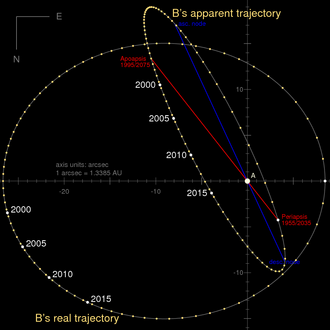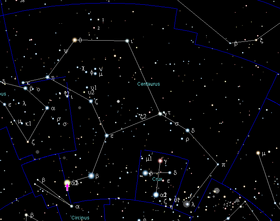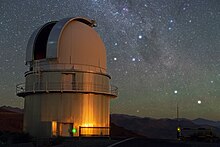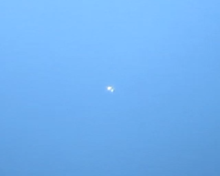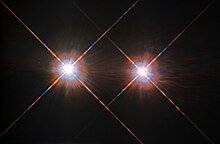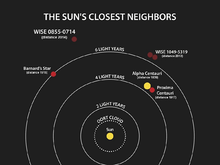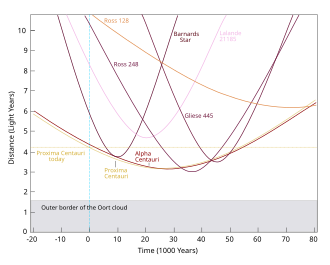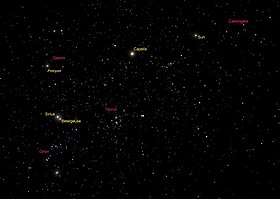
α Centauri AB is the bright star to the left, with Proxima Centauri circled in red. The bright star to the right is β Centauri.
| |
| Observation data Epoch J2000.0 Equinox J2000.0 | |
|---|---|
| Constellation | Centaurus |
| Alpha Centauri A | |
| Right ascension | 14h 39m 36.49400s |
| Declination | –60° 50′ 02.3737″ |
| Apparent magnitude (V) | +0.01 |
| Alpha Centauri B | |
| Right ascension | 14h 39m 35.06311s |
| Declination | –60° 50′ 15.0992″ |
| Apparent magnitude (V) | +1.33 |
| Characteristics | |
| A | |
| Spectral type | G2V |
| U−B color index | +0.24 |
| B−V color index | +0.71 |
| B | |
| Spectral type | K1V |
| U−B color index | +0.68 |
| B−V color index | +0.88 |
| Astrometry | |
| A | |
| Radial velocity (Rv) | −21.4±0.76 km/s |
| Proper motion (μ) | RA: −3679.25 mas/yr Dec.: 473.67 mas/yr |
| Parallax (π) | 754.81 ± 4.11 mas |
| Distance | 4.37 ly |
| Absolute magnitude (MV) | 4.38 |
| B | |
| Radial velocity (Rv) | −18.6±1.64 km/s |
| Proper motion (μ) | RA: −3614.39 mas/yr Dec.: 802.98 mas/yr |
| Parallax (π) | 754.81 ± 4.11 mas |
| Distance | 4.37 ly |
| Absolute magnitude (MV) | 5.71 |
| Details | |
| Alpha Centauri A | |
| Mass | 1.100 M☉ |
| Radius | 1.2234±0.0053 R☉ |
| Luminosity | 1.519 L☉ |
| Surface gravity (log g) | 4.30 cgs |
| Temperature | 5,790 K |
| Metallicity [Fe/H] | 0.20 dex |
| Rotation | 22±5.9 d |
| Rotational velocity (v sin i) | 2.7±0.7 km/s |
| Alpha Centauri B | |
| Mass | 0.907 M☉ |
| Radius | 0.8632±0.0037 R☉ |
| Luminosity | 0.5002 L☉ |
| Surface gravity (log g) | 4.37 cgs |
| Temperature | 5,260 K |
| Metallicity | 0.23 |
| Rotation | 36 days |
| Rotational velocity (v sin i) | 1.1±0.8 km/s |
| Age | 5.3±0.3 Gyr |
| Orbit | |
| Primary | A |
| Companion | B |
| Period (P) | 79.91±0.011 yr |
| Semi-major axis (a) | 17.57±0.022″ |
| Eccentricity (e) | 0.5179±0.00076 |
| Inclination (i) | 79.205±0.041° |
| Longitude of the node (Ω) | 204.85±0.084° |
| Periastron epoch (T) | 1875.66±0.012 |
| Argument of periastron (ω) (secondary) | 231.65±0.076° |
| Other designations | |
| α Cen A: Rigil Kentaurus, Rigil Kent, α1 Centauri, HR 5459, HD 128620, GCTP 3309.00, LHS 50, SAO 252838, HIP 71683 | |
| α Cen B: Toliman, α2 Centauri, HR 5460, HD 128621, LHS 51, HIP 71681 | |
| Database references | |
| SIMBAD | AB |
| A | |
| B | |
| Exoplanet Archive | data |
| ARICNS | data |
| Extrasolar Planets Encyclopaedia | data |
Alpha Centauri is the closest star system and closest planetary system to the Solar System at 4.37 light-years (1.34 pc) from the Sun. It is a triple star system, consisting of three stars: α Centauri A (officially Rigil Kentaurus), α Centauri B (officially Toliman), and α Centauri C (officially Proxima Centauri).
Alpha Centauri A and B are Sun-like stars (Class G and K), and together they form the binary star Alpha Centauri AB. To the naked eye, the two main components appear to be a single star with an apparent magnitude of −0.27, forming the brightest star in the southern constellation of Centaurus and the third-brightest in the night sky, outshone only by Sirius and Canopus.
Alpha Centauri A has 1.1 times the mass and 1.519 times the luminosity of the Sun, while Alpha Centauri B is smaller and cooler, at 0.907 times the Sun's mass and 0.445 times its luminosity. The pair orbit about a common center with an orbital period of 79.91 years. Their elliptical orbit is eccentric, so that the distance between A and B varies from 35.6 astronomical units (AU), or about the distance between Pluto and the Sun, to that between Saturn and the Sun (11.2 AU).
Alpha Centauri C, or Proxima Centauri, is a small and faint red dwarf (Class M). Though not visible to the naked eye, Proxima Centauri is the closest star to the Sun at a distance of 4.24 light-years (1.30 pc), slightly closer than Alpha Centauri AB. Currently, the distance between Proxima Centauri and Alpha Centauri AB is about 13,000 astronomical units (0.21 ly), equivalent to about 430 times the radius of Neptune's orbit. Proxima Centauri b is an Earth-sized exoplanet in the habitable zone of Proxima Centauri; it was discovered in 2016.
Nomenclature
α Centauri (Latinized to Alpha Centauri) is the system's Bayer designation. It once bore the name Rigil Kentaurus, which is a Latinisation of the Arabic name رجل القنطورس Rijl al-Qanṭūris, meaning 'Foot of the Centaur'.
Alpha Centauri C was discovered in 1915 by Robert T. A. Innes, who suggested that it be named Proxima Centaurus, later amended to Proxima Centauri. The name is from Latin, meaning 'nearest [star] of Centaurus'.
In 2016, the Working Group on Star Names of the International Astronomical Union, having decided to attribute proper names to individual stars rather than entire multiple systems, approved the names Rigil Kentaurus for Alpha Centauri A and Proxima Centauri for Alpha Centauri C. In 10 August 2018, IAU approved the name Toliman for Alpha Centauri B.
Stellar system
Alpha Centauri is a triple star system, with its two main stars, Alpha Centauri A and Alpha Centauri B, being a binary component. The AB designation, or older A×B, denotes the mass center of a main binary system relative to companion star(s) in a multiple star system. AB-C
refers to the component of Proxima Centauri in relation to the central
binary, being the distance between the centre of mass and the outlying
companion. Because the distance between Proxima (C) and either of Alpha
Centauri A or B is similar, the AB binary system is sometimes treated as
a single gravitational object.
Orbital properties
Apparent
and true orbits of Alpha Centauri. The A component is held stationary,
and the relative orbital motion of the B component is shown. The
apparent orbit (thin ellipse) is the shape of the orbit as seen by an
observer on Earth. The true orbit is the shape of the orbit viewed
perpendicular to the plane of the orbital motion. According to the
radial velocity vs. time,
the radial separation of A and B along the line of sight had reached a
maximum in 2007, with B being further from Earth than A. The orbit is
divided here into 80 points: each step refers to a timestep of approx.
0.99888 years or 364.84 days.
The A and B components of Alpha Centauri have an orbital period of 79.91 years. Their orbit is moderately eccentric, e = 0.5179;
their closest approach is 11.2 AU (1.68 billion km), or about the
distance between the Sun and Saturn; and their furthest separation is
35.6 AU (5.33 billion km), about the distance between the Sun and Pluto.
Viewed from Earth, the apparent orbit of A and B means that their separation and position angle (PA) are in continuous change throughout their projected orbit. Observed stellar positions in 2019 are separated by 4.92 arcsec through the PA of 337.1°, increasing to 5.49 arcsec through 345.3° in 2020. The closest recent approach was in February 2016, at 4.0 arcsec through the PA of 300°. The observed maximum separation of these stars is about 22 arcsec, while the minimum distance is 1.7 arcsec. The widest separation occurred during February 1976, and the next will be in January 2056.
The most recent, true orbit, closest approach or periastron was in August 1955, and the next will be in May 2035. The furthest orbital separation or apastron
last occurred in May 1995, and the next will be in 2075. The apparent
distance between Alpha Centauri A and B is rapidly decreasing, at least
until 2019.
Alpha Centauri C is about 13,000 astronomical units (AU) away from Alpha Centauri AB.
This is equivalent to 0.21 ly or 1.9 trillion km—about 5% the distance
between Alpha Centauri AB and the Sun. For a long time, estimates of
Proxima's small orbital speed around AB were insufficiently accurate to
determine whether Proxima Centauri is bound to the Alpha Centauri system
or an unrelated star that happens to be passing by at a low speed.
Radial velocity measurements made in 2017 were precise enough to
show that Proxima Centauri and Alpha Centauri AB are gravitationally
bound. The orbital period of Proxima Centauri is approximately 547000+6600
−4000 years, with an eccentricity of 0.50 ± 0.08, more eccentric than Mercury's. Proxima Centauri comes within 4300+1100
−900 AU of AB at periastron, and the apastron occurs at 13000+300
−100 AU.
−4000 years, with an eccentricity of 0.50 ± 0.08, more eccentric than Mercury's. Proxima Centauri comes within 4300+1100
−900 AU of AB at periastron, and the apastron occurs at 13000+300
−100 AU.
Physical properties
The relative sizes and colors of stars in the Alpha Centauri system, compared to the Sun
Asteroseismic studies, chromospheric activity, and stellar rotation (gyrochronology) are all consistent with the Alpha Centauri system being similar in age to, or slightly older than, the Sun.
Asteroseismic analyses that incorporate tight observational constraints
on the stellar parameters for the Alpha Centauri stars have yielded age
estimates of 4.85±0.5 Gyr, 5.0±0.5 Gyr, 5.2 ± 1.9 Gyr, 6.4 Gyr, and 6.52±0.3 Gyr.
Age estimates for the stars based on chromospheric activity (Calcium H
& K emission) yield 4.4 ± 2.1 Gyr, whereas gyrochronology yields 5.0±0.3 Gyr. Stellar evolution
theory implies both stars are slightly older than the Sun at 5 to
6 billion years, as derived by their mass and spectral characteristics.
From the orbital elements, the total mass of Alpha Centauri AB is about 2.0 M☉—or twice that of the Sun. The average individual stellar masses are 1.09 M☉ and 0.90 M☉, respectively, though slightly higher masses have been quoted in recent years, such as 1.14 M☉ and 0.92 M☉, or totaling 2.06 M☉. Alpha Centauri A and B have absolute magnitudes of +4.38 and +5.71, respectively.
Alpha Centauri A
Alpha Centauri A, also known as Rigil Kentaurus, is the principal member, or primary, of the binary system. It is a solar-like main-sequence star with a similar yellowish color, whose stellar classification is spectral type G2 V; it is slightly larger and more luminous than the Sun. Alpha Centauri A is about 10 percent more massive than the Sun, with a radius about 22 percent larger. When considered among the individual brightest stars in the sky (excluding the Sun), it is the fourth brightest at an apparent magnitude of −0.01, being slightly fainter than Arcturus at an apparent magnitude of −0.04.
The type of magnetic activity on Alpha Centauri A is comparable to that of the Sun, showing coronal variability due to star spots,
as modulated by the rotation of the star. However, since 2005 the
activity level has fallen into a deep minimum that might be similar to
the Sun's historical Maunder Minimum. Alternatively, it may have a very long stellar activity cycle and is slowly recovering from a minimum phase.
Alpha Centauri B
Alpha Centauri B, also known as Toliman, is the secondary
star of the binary system. It is a main-sequence star of spectral type
K1 V, making it more an orange colour than Alpha Centauri A;
it has around 90 percent the mass of the Sun and a 14 percent smaller
diameter. Although it has a lower luminosity than A, Alpha Centauri B
emits more energy in the X-ray band. Its light curve varies on a short time scale, and there has been at least one observed flare. It is more magnetically active than Alpha Centauri A, showing a cycle of 8.2±0.2 yr compared to 11 years for the Sun, and about half the minimum-to-peak variation in coronal luminosity of the Sun. Alpha Centauri B has an apparent magnitude of +1.35, slightly dimmer than Beta Crucis.
Alpha Centauri C
Alpha Centauri C, better known as Proxima Centauri, is a small main-sequence red dwarf of spectral class M6 Ve. It has an absolute magnitude of +15.60, over 20,000 times fainter than the Sun. Its mass is calculated to be 0.1221 M☉.
Relative
positions of Sun, Alpha Centauri AB and Proxima Centauri. Grey dot is
projection of Proxima Centauri, located at the same distance as Alpha
Centauri AB.
Observation
Location of Alpha Centauri in Centaurus
The two bright stars at the lower right are Alpha (right) and Beta Centauri (left, above antenna). A line drawn through them points to the four bright stars of the Southern Cross, just to the right of the dome of La Silla Observatory.
To the naked eye, Alpha Centauri AB appears to be a single star, the brightest in the southern constellation of Centaurus. Their apparent angular separation varies over about 80 years between 2 and 22 arcsec (the naked eye has a resolution of 60 arcsec), but through much of the orbit, both are easily resolved in binoculars or small telescopes. At −0.27 apparent magnitude (combined for A and B magnitudes), Alpha Centauri is fainter only than Sirius and Canopus. It forms the outer star of The Pointers or The Southern Pointers, so called because the line through Beta Centauri (Hadar/Agena),
some 4.5° west, points to the constellation Crux—the Southern Cross. The Pointers easily distinguish the true Southern Cross from the fainter asterism known as the False Cross.
Alpha
Centauri AB taken in daylight by holding a Canon Powershot S100 behind
the eyepiece of a 110 mm refractor. The photo is one of the best frames
of a video. The double star is clearly visible.
South of about 29° S latitude, Alpha Centauri is circumpolar and never sets below the horizon.
North of about 29° N latitude, Alpha Centauri never rises. Alpha
Centauri lies close to the southern horizon when viewed from the 29° N latitude to the equator (close to Hermosillo, Chihuahua City in Mexico, Galveston, Texas, Ocala, Florida and Lanzarote, the Canary Islands of Spain), but only for a short time around its culmination. The star culminates each year at local midnight on 24 April and at local 9 p.m. on 8 June.
As seen from Earth, Proxima Centauri is 2.2° southwest from Alpha Centauri AB, about four times the angular diameter of the Moon.
Proxima Centauri appears as a deep-red star of a typical apparent
magnitude of 11.1 in a sparsely populated star field, requiring
moderately sized telescopes to be seen. Listed as V645 Cen in the General Catalogue of Variable Stars Version 4.2, this UV Ceti-type flare star can unexpectedly brighten rapidly by as much as 0.6 magnitudes at visual wavelengths, then fade after only a few minutes. Some amateur and professional astronomers regularly monitor for outbursts using either optical or radio telescopes.
In August 2015, the largest recorded flares of the star occurred, with
the star becoming 8.3 times brighter than normal on 13 August, in the B band (blue light region).
Observational history
View of Alpha Centauri from the Digitized Sky Survey 2
Alpha Centauri is listed in the 2nd-century star catalog of Ptolemy. He gave its ecliptic coordinates, but texts differ as to whether the ecliptic latitude reads 44° 10′ South or 41° 10′ South. (Presently the ecliptic latitude is 43.5° South, but it has decreased by a fraction of a degree since Ptolemy's time due to proper motion.) In Ptolemy's time, Alpha Centauri was visible from Alexandria, Egypt, at 31° N, but, due to precession, its declination is now –60° 51′ South, and it can no longer be seen at that latitude. English explorer Robert Hues brought Alpha Centauri to the attention of European observers in his 1592 work Tractatus de Globis, along with Canopus and Achernar, noting:
Now, therefore, there are but three Stars of the first magnitude that I could perceive in all those parts which are never seene here in England. The first of these is that bright Star in the sterne of Argo which they call Canobus. The second [Achernar] is in the end of Eridanus. The third [Alpha Centauri] is in the right foote of the Centaure.
The binary nature of Alpha Centauri AB was recognised in December 1689 by Jean Richaud, while observing a passing comet from his station in Puducherry. Alpha Centauri was only the second binary star to be discovered, preceded by Alpha Crucis.
The large proper motion of Alpha Centauri AB was discovered by Manuel John Johnson, observing from Saint Helena, who informed Thomas Henderson at the Royal Observatory, Cape of Good Hope
of it. The parallax of Alpha Centauri was subsequently determined by
Henderson from many exacting positional observations of the AB system
between April 1832 and May 1833. He withheld his results, however,
because he suspected they were too large to be true, but eventually
published them in 1839 after Friedrich Wilhelm Bessel released his own accurately determined parallax for 61 Cygni in 1838.
For this reason, Alpha Centauri is sometimes considered as the second
star to have its distance measured because Henderson's work was not
fully acknowledged at first. (The distance of Alpha Centauri from the Earth is now reckoned at 4.396 ly or 41.59 trillion km.)
Compared to the Sun, Alpha Centauri A is of the same stellar type G2, while Alpha Centauri B is a K1-type star.
Later, John Herschel made the first micrometrical observations in 1834. Since the early 20th century, measures have been made with photographic plates.
By 1926, William Stephen Finsen calculated the approximate orbit elements close to those now accepted for this system.
All future positions are now sufficiently accurate for visual observers
to determine the relative places of the stars from a binary star ephemeris. Others, like D. Pourbaix (2002), have regularly refined the precision of new published orbital elements.
Robert T. A. Innes discovered Proxima Centauri in 1915 by blinking photographic plates taken at different times during a proper motion
survey. These showed large proper motion and parallax similar in both
size and direction to those of Alpha Centauri AB, suggesting that
Proxima Centauri is part of the Alpha Centauri system and slightly
closer to Earth than Alpha Centauri AB. Lying 4.24 ly (1.30 pc) away,
Proxima Centauri is the nearest star to the Sun.
Kinematics
All components of Alpha Centauri display significant proper motion against the background sky. Over centuries, this causes their apparent positions to slowly change. Proper motion was unknown to ancient astronomers. Most assumed that the stars are immortal and permanently fixed on the celestial sphere, as stated in the works of the philosopher Aristotle. In 1718, Edmond Halley found that some stars had significantly moved from their ancient astrometric positions.
In the 1830s, Thomas Henderson discovered the true distance to Alpha Centauri by analysing his many astrometric mural circle observations. He then realized this system also likely had a high proper motion. In this case, the apparent stellar motion was found using Nicolas Louis de Lacaille's astrometric observations of 1751–1752, by the observed differences between the two measured positions in different epochs.
Calculated proper motion of the center of mass for Alpha Centauri AB is about 3620 mas (milli-arcseconds)
per year toward the west and 694 mas/y toward the north, giving an
overall motion of 3686 mas/y in a direction 11° north of west. The motion of the center of mass is about 6.1 arcmin each century, or 1.02° each millennium. The velocity in the western direction is 23.0 km/s and in the northerly direction 4.4 km/s. Using spectroscopy the mean radial velocity has been determined to be around 22.4 km/s towards the Solar System.
Since Alpha Centauri AB is almost exactly in the plane of the Milky Way
as viewed from Earth, there are many stars behind them. In early May
2028, Alpha Centauri A will pass between us and a distant red star, when
there will be a 45% probability that an Einstein ring will be observed. Other conjunctions
will also occur in the coming decades, allowing accurate measurement of
proper motions and possibly giving information on planets.
Predicted future changes
Distances of the nearest stars from 20,000 years ago until 80,000 years in the future
Animation
showing motion of Alpha Centauri through the sky. (The other stars are
held fixed for didactic reasons.) "Oggi" means today.
As the stars of Alpha Centauri move closer to the Solar System, their measured proper motions, trigonometric parallaxes and radial velocities slowly increase.
These effects will continue until the star system reaches its nearest
point to the Sun, and then reverse as the distance increases again. Furthermore, other small changes also occur with the binary star's orbital elements. For example, in the apparent size of the semi-major axis of the orbital ellipse will increase by 0.03 arcsec per century. Also the observed position angles of the stars are also subject to small cumulative changes (additional to position angle changes caused by the precession of the equinoxes), as first determined by W. H. van den Bos in 1926.
Apparent motion of Alpha Centauri relative to β Centauri. The minimum separation will actually be greater than shown in this figure.
Based on the system's common known proper motion and radial
velocities, Alpha Centauri will continue to change its position in the
sky significantly and will gradually brighten. For example, in about
6,200 AD, α Centauri's true motion will cause an extremely rare first-magnitude stellar conjunction with β Centauri, forming a brilliant optical double star in the southern sky. It will then pass just north of the Southern Cross or Crux, before moving northwest and up towards the present celestial equator and away from the galactic plane. By about 29,700 AD, in the present-day constellation of Hydra, Alpha Centauri will be 1.00 pc or 3.3 ly away, though later calculations suggest 0.90 pc or 2.9 ly in 29,000 AD. At nearest approach, Alpha Centauri will attain a maximum apparent magnitude of −0.86, comparable to present-day magnitude of Canopus, but it will still not surpass that of Sirius,
which will brighten incrementally over the next 60,000 years, and will
continue to be the brightest star as seen from Earth (other than the
Sun) for the next 210,000 years.
About 28,000 years from now, the Alpha Centauri system will begin to slowly move away from the Solar System, and this bright yellow star will eventually fall below naked-eye visibility.
Planetary system
Confirmed planets
Only one planet has been confirmed for the Alpha Centauri system: Proxima Centauri b. It is slightly larger than the Earth, and orbits around Proxima Centauri in the habitable zone.
The existence of Proxima Centauri b was announced in 2016 by the
European Southern Observatory. It was found using the radial velocity
method, where periodic Doppler shifts of spectral lines of the host star
suggest an orbiting object.
Controversial and hypothetical planets
Alpha Centauri Bb
In 2012, a planet around Alpha Centauri B was announced, Alpha Centauri Bb,
but in 2015 a new analysis concluded that it almost certainly does not
exist and was just a spurious artifact of the data analysis.
Alpha Centauri Bc
The existence of a planet, Alpha Centauri Bc, was announced in 2013. It has an estimated orbital period of approximately 12 Earth days – less than that of Mercury – with a semimajor axis of 0.10 AU and an eccentricity smaller than 0.24.
In 2015, transit results for Alpha Centauri B obtained using the Hubble Space Telescope were published. They evidence a transit event possibly corresponding to a planetary body with a radius around 0.92 R⊕.
This planet would most likely orbit Alpha Centauri B with an orbital
period of 20.4 days or less, with only a 5 percent chance of it having a
longer orbit. The median of the likely orbits is 12.4 days with an
impact parameter of around 0–0.3. Its orbit would likely have an
eccentricity of 0.24 or less. Like the probably spurious Alpha Centauri
Bb, it likely has lakes of molten lava and would be far too close to
Alpha Centauri B to harbor life.
Hypothetical planets
Additional
planets may exist in the Alpha Centauri system, either orbiting Alpha
Centauri A or Alpha Centauri B individually, or in large orbits around
Alpha Centauri AB. Because both stars are fairly similar to the Sun (for
example, in age and metallicity), astronomers have been especially interested in making detailed searches for planets in the Alpha Centauri system. Several established planet-hunting teams have used various radial velocity or star transit methods in their searches around these two bright stars. All the observational studies have so far failed to find evidence for brown dwarfs or gas giants.
In 2009, computer simulations showed that a planet might have
been able to form near the inner edge of Alpha Centauri B's habitable
zone, which extends from 0.5 to 0.9 AU from the star. Certain special
assumptions, such as considering that the Alpha Centauri pair may have
initially formed with a wider separation and later moved closer to each
other (as might be possible if they formed in a dense star cluster), would permit an accretion-friendly environment farther from the star.
Bodies around Alpha Centauri A would be able to orbit at slightly
farther distances due to its stronger gravity. In addition, the lack of
any brown dwarfs or gas giants in close orbits around Alpha Centauri
make the likelihood of terrestrial planets greater than otherwise. A theoretical study indicates that a radial velocity analysis might detect a hypothetical planet of 1.8 M⊕ in Alpha Centauri B's habitable zone.
Radial velocity measurements of Alpha Centauri B with High Accuracy Radial Velocity Planet Searcher spectrograph ruled out planets of more than 4 M⊕ to[clarification needed] the distance of the habitable zone of the star (orbital period P = 200 days).
Current estimates place the probability of finding an Earth-like planet around Alpha Centauri at roughly 85%.
The observational thresholds for planet detection in the habitable
zones by the radial velocity method are currently (2017) estimated to be
about 50 M⊕ for Alpha Centauri A, 8 M⊕ for Alpha Centauri B, and 0.5 M⊕ for Proxima Centauri.
Early computer-generated models of planetary formation predicted the existence of terrestrial planets around both Alpha Centauri A and B,
but most recent numerical investigations have shown that the
gravitational pull of the companion star renders the accretion of
planets difficult. Despite these difficulties, given the similarities to the Sun in spectral types,
star type, age and probable stability of the orbits, it has been
suggested that this stellar system could hold one of the best
possibilities for harbouring extraterrestrial life on a potential planet.
In the Solar System, Jupiter and Saturn were probably crucial in perturbing comets into the inner Solar System, providing the inner planets with a source of water and various other ices.
In the Alpha Centauri system, Proxima Centauri may have influenced the
planetary disk as the Alpha Centauri system was forming, enriching the
area around Alpha Centauri with volatile materials.
This would be discounted if, for example, Alpha Centauri B happened to
have gas giants orbiting Alpha Centauri A (or conversely, Alpha
Centauri A for Alpha Centauri B), or if Alpha Centauri A and B
themselves were able to perturb comets into each other's inner system as
Jupiter and Saturn presumably have done in the Solar System. Such icy bodies probably also reside in Oort clouds
of other planetary systems. When they are influenced gravitationally
by either the gas giants or disruptions by passing nearby stars, many of
these icy bodies then travel starward.
Such ideas also apply to the close approach of Alpha Centauri or other
stars to the Solar System, when, in the distant future, the Oort Cloud
might be disrupted enough to increase the number of active comets.
To be in the habitable zone, a planet around Alpha Centauri A would have an orbital radius of about 1.25 AU
so as to have similar planetary temperatures and conditions for liquid
water to exist. For the slightly less luminous and cooler Alpha Centauri
B, the habitable zone is closer at about 0.7 AU (100 million km).
With the goal of finding evidence of such planets, both Proxima
Centauri and Alpha Centauri AB were among the listed "Tier 1" target
stars for NASA's Space Interferometry Mission (SIM). Detecting planets as small as three Earth-masses or smaller within two astronomical units of a "Tier 1" target would have been possible with this new instrument.[99] The SIM mission, however, was cancelled due to financial issues in 2010.
Circumstellar discs
Based
on observations between 2007 and 2012, a study found a slight excess of
emissions in the 24 µm (mid/far-infrared) band surrounding α Centauri AB, which may be interpreted as evidence for a sparse circumstellar disc or dense interplanetary dust. The total mass was estimated to be between 10−7 to 10−6 the mass of the Moon, or 10–100 times the mass of the Solar System's zodiacal cloud. If such a disc existed around both stars, α Centauri A's disc would likely be stable to 2.8 AU, and α Centauri B's would likely be stable to 2.5 AU. This would put A's disc entirely within the frost line, and a small part of B's outer disc just outside.
View from this system
Looking towards the sky around Orion from Alpha Centauri with Sirius near Betelgeuse, Procyon in Gemini, and the Sun in Cassiopeia generated by Celestia
The Sun in the constellation Cassiopeia as seen from Alpha Centauri
The sky from Alpha Centauri AB would appear much as it does from the Earth, except that Centaurus would be missing its brightest star. The Sun would appear as a yellow star of apparent magnitude +0.5, roughly the same as the average brightness of Betelgeuse from Earth. It would be at the antipodal point of Alpha Centauri AB's current right ascension and declination, at 02h 39m 35s +60° 50′ (2000), in eastern Cassiopeia, easily outshining all the rest of the stars in the constellation. With the placement of the Sun east of the 3.4-magnitude star ε Cassiopeiae, it would be nearly in front of the Heart Nebula, and the "W" of Cassiopeia would appear as a "/W" shape.
The Winter Triangle would have a very different appearance, with Procyon outshining Pollux in the middle of Gemini, and Sirius lying less than a degree from Betelgeuse in Orion.
With a magnitude of −1.2, Sirius would be a little fainter than from
Earth but still the brightest star in the night sky. Both Vega and Altair would be shifted northwestward relative to Deneb, giving the Summer Triangle a more equilateral appearance.
Alpha Centauri is inside the G-cloud, and its nearest known system is the binary brown dwarf system Luhman 16 at 3.6 ly (1.1 pc).
Other names
In modern literature, Rigil Kent (also Rigel Kent and variants; /ˈraɪdʒəl
Rigil Kent is short for Rigil Kentaurus, which is sometimes further abbreviated to Rigil or Rigel, though that is ambiguous with β Orionis, which is also called Rigel.
The name Toliman originates with Jacobus Golius' 1669 edition of Al-Farghani's Compendium. Tolimân is Golius' latinisation of the Arabic name الظلمان al-Ẓulmān "the ostriches", the name of an asterism of which Alpha Centauri formed the main star.
During the 19th century, the northern amateur popularist Elijah H. Burritt used the now-obscure name Bungula, possibly coined from "β" and the Latin ungula ("hoof").
Together, Alpha and Beta Centauri form the "Southern Pointers" or "The Pointers", as they point towards the Southern Cross, the asterism of the constellation of Crux.
In Standard Mandarin Chinese, 南門 Nán Mén, meaning Southern Gate, refers to an asterism consisting of α Centauri and ε Centauri. Consequently, α Centauri itself is known as 南門二 Nán Mén Èr, the Second Star of the Southern Gate.
To the Australian aboriginal Boorong people of northwestern Victoria, α Centauri and β Centauri are Bermbermgle, two brothers noted for their courage and destructiveness, who speared and killed Tchingal "The Emu" (the Coalsack Nebula). The form in Wotjobaluk is Bram-bram-bult.
Future exploration
The Very Large Telescope and Alpha Centauri.
Alpha Centauri is a likely first target for manned or unmanned interstellar exploration.
Using current spacecraft technologies, crossing the distance between
the Sun and Alpha Centauri would take several millennia, though the
possibility of nuclear pulse propulsion or laser light sail technology, as considered in the Breakthrough Starshot program, could reduce the journey time to decades. An objective of such a mission would be to make a fly-by of, and possibly photograph, planets that might exist in the system. The existence of Proxima Centauri b, announced by the European Southern Observatory (ESO) in August 2016, would be a target for the Starshot program.
In January 2017, Breakthrough Initiatives and the ESO entered a
collaboration to search for habitable planets in the Alpha Centauri
system. The agreement involves Breakthrough Initiatives providing
funding for an upgrade to the VISIR (VLT Imager and Spectrometer for mid-Infrared) instrument on ESO's Very Large Telescope (VLT) in Chile. This upgrade will greatly increase the likelihood of planet detection in the system.
